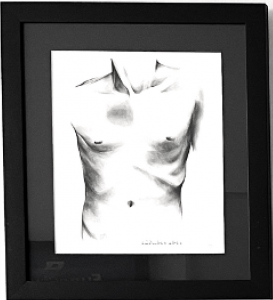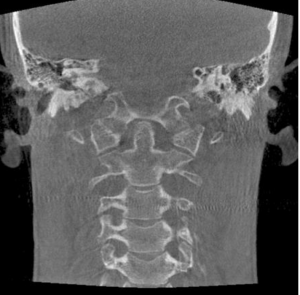TMCC: Temporomandibular Cervical Chain
The other polyarticular chain described in Postural Restoration Institute ® is TMCC (Temporomandibular Cervical Chain). The main function of the TMCC is;
- to control your neck
- to provide stability for the neck during respiration
- to provide support for the scapula
- to provide support for the voice box
- to provide the base for your skull and jaw (Temporomandibular joint)
The dominant pattern is the right TMCC pattern to compensate underlying L AIC and R BC pattern.


Muscles: Temporalis (ant. fiber), Masseter, Medial pterygoid, Rectus capitis posterior major, Obliquus capitis, Rectus capitis anterior, Longus capitis, Longus colli
The right TMCC pattern is often associated with the Left Sideband of the cranial strain. As you can see from the picture below, the pattern affects the jaw (Temporomandibular joint), occlusion, as well as alignment of the teeth.

The other common cranial pattern associated with the Right TMCC pattern is the Right torsion.

Symptoms often associated with Right TMCC are:
- TMJ disorders such as: Jaw pain, difficulty chewing, and clicking and locking of the jaw joint are some of the symptoms
- Occlusion issues (although it is not a scope of physical therapy) such as:
- Open bite, crossbites, crowded teeth, intorsion
- Airway restriction due to the position of the cervical spine, tongue, jaw, and muscular imbalances
- Autonomic imbalance (including direct stress on the vagus nerve)
- Headache
- Voice production issues due to mechanical dysfunction or the vagus N. dysfunction
- Sphenobaisier Symphysis dysfunction1
- Dysfunction of the endocrine system
- Dysregulation of internal processes (Sensory Integration issues)
- Impaired cerebrospinal fluid (CSF) flow
- Decreased or imbalanced motion of the craniosacral system
Treatment
In the PRI approach, the right TMCC pattern is characterized by:
- Decrease asymmetrical alignment and function of the jaw, head, and neck
- Normal range of motion in the jaw, neck, and head
- Optimal muscle function and coordination in the head, neck, and jaw region
- Reduction of stress and asymmetrical force patterns in the TMCC and other regions of the body
It is important to note that the right TMCC pattern may vary for each individual, and an assessment by a PRI-trained physical therapist is necessary to determine the best course of treatment to restore optimal TMCC function.
1, Magoun, H.I., Sr., A.B., D.O., F.A.A.O., Osteopathy in the Cranial Field, Third Edition, The Journal Printing Company, Kirksville, Missouri, 1976.

